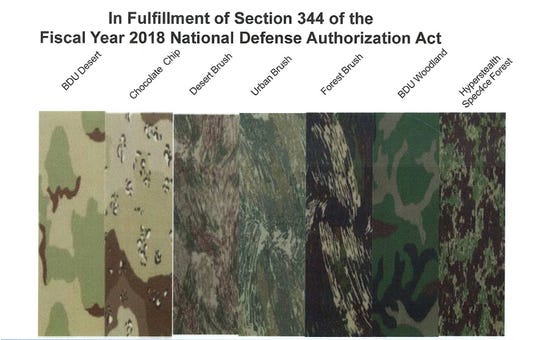Tom Vanden Brook
WASHINGTON – When it went shopping for new Afghan army uniforms, the Pentagon ending up outfitting soldiers in the most expensive and one of the least effective camouflage designs.
In a new report the U.S. military has sought to keep quiet, American taxpayers footed the $28 million bill for the poor choice of 430,000 uniforms.
“I’d hate to be an Afghan soldier wearing that uniform," said John Sopko, the U.S. Inspector General for Afghanistan Reconstruction. "It’s like having ‘shoot me’ written on the back.”
The report backs the finding in 2017 of the Inspector General that determined the Pentagon had wasted as much as $28 million buying uniforms with woodland camouflage pattern appropriate for about 2% of mostly arid Afghanistan.
The first three patterns, from the left, were determined to be the least detectable and least expensive of all seven. However, the pattern selected for 430,000 uniform sets for the Afghan military was the Hyperstealth Spec4cd Forest, far right, which with the BDU Woodland design was the most detectable. And Hyperstealth was the most expensive.
With U.S. military consent, the Afghan defense minister chose the proprietary camouflage pattern that required paying licensing fees despite having more effective patterns owned by the Pentagon. The pattern had not been tested for its suitability in Afghanistan until Congress required a new study in 2018.
That report, which was labeled, For Official Use Only, was obtained by USA TODAY.
The Afghan uniform "is the most expensive of seven patterns tested and, along with BDU Woodland Forest, is the most detectable," according to the findings of the new report. The pattern known as Spec4ce Forest, is the only one of the seven that requires the Pentagon to pay licensing fees.
Then-Defense Secretary Jim Mattis was outraged by the wasteful spending. He warned the Pentagon bureaucracy in a memo that such "cavalier or casually acquiescent decisions to spend taxpayer dollars in an ineffective and wasteful manner are not to recur."
The inspector general determined that the Pentagon could save as much as $71 million over the next 10 years by switching to a new camouflage scheme. As of 2017, the Pentagon had spent $93 million to buy 1.3 million uniforms in the forest camouflage pattern for the Afghan army.
Since the war began, there have been 2,400 U.S. troops killed in action.
The new study noted that Congress has required the Pentagon to determine if there is a more effective alternative uniform. The Pentagon commissioned a study by a West Point professor of cognitive science to examine the uniform best suited to Afghanistan.
A choice of the Spec4ce Forest design could hardly have been worse, when cheaper, more effective alternatives were available, the report concluded.
"Uniforms that used the three patterns determined to be the least detectable would be the least expensive to procure," according to the report.
Findings in the study were revealed Wednesday at a House Oversight committee hearing on reconstruction in Afghanistan. Since 2002, the U.S. has spent $132 billion to train and equip Afghan security forces, support its government, protect women's rights and improve health and education, according to the inspector general.
Those investments have failed to stabilize the country, which continues to struggle with Taliban insurgents, corruption and poverty. A recent report by Sopko noted that negotiations that result in peace present challenges if the Taliban fail to reintegrate into Afghan society.
Sopko, in testimony Wednesday, said he assumed that the poor choice of uniforms is due to bribery. In the end, Afghan soldiers pay the highest price, he said.

No comments:
Post a Comment